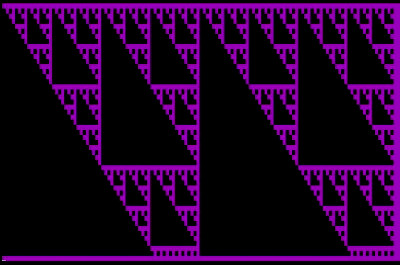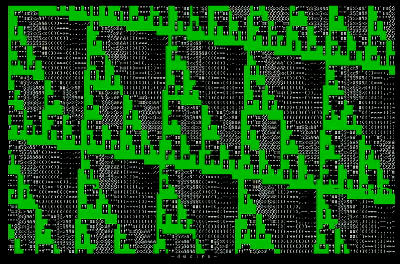Lovebyte 2022 ARM/Linux sizecoded Demos
Background
Lovebyte is a demoparty aimed directly
at sizecoding! In addition to my usual
Apple II submissions I also did
a Raspberry Pi baremetal bootsector demo.
Source Code
The full source code for all of these entries is available on my
armdemo
github project.
The Entries
High-end 128B -- Thumbpinski

I'm teaching ARM THUMB2 assembly language this semester, so I thought
I'd try some coding practice to refresh my ARM skills, otherwise I might
accidentally end up teaching 6502 assembly to the students instead.
I wanted to see how small of a program I could write for Linux on a
Raspberry Pi. It turns out that with the bare minimum ELF header is
around 84 bytes, which doesn't leave much room.
In the end I used some techniques like in the
Tiny Elf Modernized document and put some of the code/data into
the ELF header.
The code is just a boring sierpinski printed to standard-output with
some ANSI escape characters for color.
There's a syscall to nanosleep() to slow things down a bit.
The executable is loaded at 0x8000
instead of 0x10000 so addresses would fit in the lower 16-bits.
Following the Lovebyte rules this could technically also be considered
a 64 byte demo if you don't count the header.
The executable is statically linked, there's no calls to the C library.
You'll want to run this on a console that's at least 128 columns wide.
Finish: 9/9 128 Byte High-end Intro
Video: https://youtu.be/H-pSN9EKQe8
Download: thumbpinski_pouet.zip
Sourcecode: sierpinski_elfabuse.s
Pouet: https://www.pouet.net/prod.php?which=90925
High-end 256B -- Thumb2 Sierzoom

This is an implementation of Hellmood's Sierpinski Zoom code from
the Memories demo, but in ARM Thumb2 assembly language for
Raspberry Pi Linux (needs a Pi with Thumb2 support, so Pi2 or later)
This fits in 240 bytes and isn't playing ELF header games, as the
algorithm ended up fitting well. It's statically linked, no calls
to any libraries.
I did include a color-changing
Desire logo. I had a few extra ideas to use up the free bytes but wasn't
able to get anything useful in before the deadline.
The graphics are ANSI escape codes and text characters. I was originally
trying for more colors rather than the text between the green, but thought
in the end it gave it a nice almost greyscale look.
The intro ran at acceptable speed over a network connection, but running
on the native Linux framebuffer was too slow. To fix this a whole
line of output is buffered before a WRITE() syscall, rather than writing
things a pixel at a time.
You'll need to set your terminal to at least 128x50 for this to work.
I should have made things slightly smaller as getting 128x50 to look reasonable
at a resolution my HDMI capture card could handle was a bit tough.
The capture was done on a Pi4 mostly because it was the most convenient
model I had around when it was time to get a capture.
Finish: 7/7 256 Byte High-end Intro
Download: sierzoom_pouet.zip
Video: https://youtu.be/4eQNolxV73Q
Sourcecode: sierzoom_asm.s
Pouet: https://www.pouet.net/prod.php?which=91035
See my Lovebyte 2022 entry for bare-metal Rapberry Pi
See my Lovebyte 2022 entries for the Apple II platform
Back to my Demos

